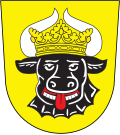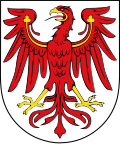- The coat of arms of the Grand Duchy of Mecklenburg-Schwerin. The Mecklenburg bull can be seen in the top left of the shield.
- The coat of arms of the Grand Duchy of Mecklenburg-Strelitz. The escutcheon is identical to that of Mecklenburg-Schwerin.
- The Pomeranian ducal arms used until the 17th century. The red Pomeranian griffin can be seen in the top centre.
- The Pomeranian griffin as used on the arms of the Prussian Province of Pomerania.
- The seal of Mecklenburg-Vorpommern until the dissolution and reorganisation of the state into districts in 1952.
| Coat of arms of Mecklenburg-Vorpommern | |
|---|---|
 | |
| Versions | |
 Lesser coat of arms | |
| Armiger | Government of Mecklenburg-Vorpommern |
| Adopted | 1990 |
| Shield | Quarterly. One and four Or, a bull's head erased Sables, langued Gules, horned Argent, crowned Or. Two Argent a griffin segreant left, armed Or. Three Argent an eagle Gules armed and beaked Or, langued Gules. The wings charged with a trefoil Or. |
| Use | Great arms for use by parliament and superior state authorities, lesser arms for lower state authorities. |
Mecklenburg-Vorpommern is a state of Germany. The greater arms of the state depict the bull's head of Mecklenburg, the griffin of Pomerania, and the red eagle of Brandenburg. The lesser arms depict only the bull's head of Mecklenburg and the griffin of Pomerania.







